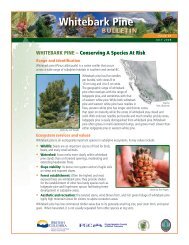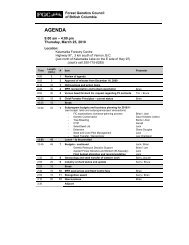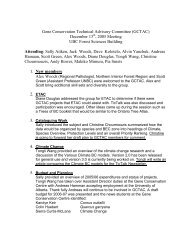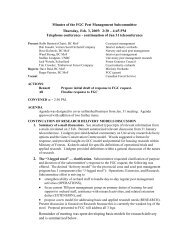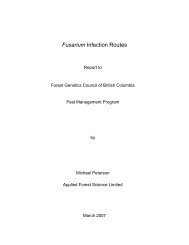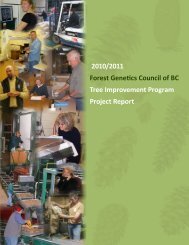Tree Improvement Program Project Report 2006 / 2007
Tree Improvement Program Project Report 2006 / 2007
Tree Improvement Program Project Report 2006 / 2007
Create successful ePaper yourself
Turn your PDF publications into a flip-book with our unique Google optimized e-Paper software.
66<br />
T R E E I M P R O V E M E N T P R O G R A M<br />
Clone ID 5-Jul 18-Jul 1-Aug 15-Aug 31-Aug 15-Sep 3-Oct totals<br />
1506 3 5 4 3 4 4 1 24<br />
1524 2 3 5 5 4 4 1 24<br />
1531 - 6 5 6 1 1 2 21<br />
1539 2 3 3 5 5 4 3 25<br />
1540 - 6 3 2 1 1 2 15<br />
totals 7 23 20 21 15 14 9 109<br />
Dates of Collection<br />
Clone ID 5-Jul 18-Jul 1-Aug 15-Aug 31-Aug 15-Sep 3-Oct<br />
Clone ID<br />
1506 F<br />
F F<br />
1524 ? F<br />
1531 ? ?<br />
F<br />
1539 ? F<br />
1540 ? F<br />
F F F<br />
Pollen<br />
receptivity<br />
stage<br />
Number<br />
cones/tree<br />
1506 late 226<br />
1524 late 68<br />
1531 mid 455<br />
1539 early 25<br />
1540 early 620<br />
Dates of Collection<br />
Table 26. Pollen recept v ty<br />
and cone product on of the<br />
five clones selected at KRS.<br />
Clone ID 5-Jul 18-Jul 1-Aug 15-Aug 31-Aug 15-Sep 3-Oct<br />
1506 LSB LSB<br />
1524 LSB LSB<br />
1531 ? ? LSB LSB<br />
1539 LSB<br />
1540 ? LSB<br />
Table 27. Table show ng the d str but on of lateral shoot buds found n<br />
the five clones collected at KRS. Quest on marks represent buds that<br />
were e ther develop ng lateral-shoot buds or female strob l .<br />
results would be similar, we can surmise that long-shoot<br />
bud length, in particular long long-shoot bud length<br />
early in the season, is characteristic of low cone producers<br />
(Figure 69). Although this relationship would appear to be<br />
significant, this is only really apparent towards the end of<br />
P R O J E C T R E P O R T 2 0 0 6 / 2 0 0 7<br />
Table 2 . Number of<br />
samples sect oned of<br />
the five clones from<br />
each collect on date.<br />
Table 2 . Develop ng female strob l found n the five<br />
clones collected from the Kalamalka Research Stat on (KRS).<br />
Quest on marks represent buds that were e ther develop ng<br />
lateral-shoot buds or female strob l .<br />
the summer, far after such a trait would be operationally<br />
useful (Figure 70).<br />
Female development is earliest in 1506, 1531, and 1540<br />
and latest in 1524 and 1539. This does not correlate with<br />
another historical measure of development in these clones,



